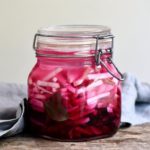Fermented Turnip Pickles
Looking for a classic turnip pickle for shawarma or falafels? The secret is fermentation! This quick, no-cook recipe is delicious and probiotic! It’s so easy and reliable that it’s perfect for first-time fermenters.
- Prep Time: 10 minutes
- Total Time: 10 minutes
- Yield: 2 cups 1x
- Category: Pickles
- Method: Fermented
- Cuisine: Middle Eastern
- Diet: Gluten Free
Ingredients
Units
Scale
- 2 cups filtered water, to cover (chlorine-free)
- 1 1/2 tsp salt (non-iodized)
- 2 cups of turnips, sliced (about 6 small or 3 large)
- 1 small beet
- 1 clove of garlic, peeled
- 2 bay leaves
Instructions
- It’s easiest to make these pickles in a quart-sized (1 L) jar. There will be a bit of extra room, but not everyone has a 3/4 L jar. Measure the salt and water into the bottom of the jar. Give it a good stir to dissolve the salt. It will take a bit of time to fully dissolve the salt, so start to prepare your vegetables, then give it another stir.
- Fresh young turnips and beets, don’t need to be peeled. Leaving the peel on is the best way to kick-start the ferment. However, older beets and turnips should be peeled because the skin is tough, even after fermenting.
- Thinly slice the turnips and beets. I like matchsticks, but thin semi-circles are just fine. Pack the vegetables, garlic, and bay into the jar.
- Turnips really like to float, so use a weight to keep the vegetables submerged. Cap with a lid that can handle fermentation, and place the jar somewhere cool and dark to ferment.
- The pickled turnips are ready after 3 days but can be left to ferment for longer (see notes for details). Once the pickles are opened, store them in the fridge and use them up within 1 month.
Notes
- All that’s necessary for these pickles is to keep the vegetables below the liquid. Use a smaller jar or a well-fitted weight. Then cover the jar with a tea towel or a non-tightened lid. This ferment will bubble, so don’t use a tight-fitting lid unless it’s designed for fermentation.
- These pickles can be left to ferment for up to a year. However, it’s important to use a sanitized jar with a gasket that is fitted to allow gas to escape. Personally, I like Fido jars.
Find it online: https://www.fermentingforfoodies.com/fermented-pickled-turnips/
